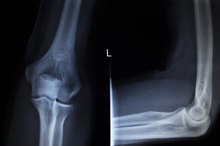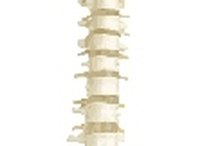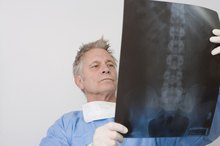Causes of Back Pain Down by the Tailbone
Back pain is a common and pervasive problem for many Americans. The American Chiropractic Association says that back pain is the second most common reason for a visit to the doctor. Pain can extend from the lumbar spine to the pelvis and into the tailbone.
Below the lumbar spine are two additional sections of bone. The first is called the sacrum, and the tiny tailbone section known as the coccyx. Pain in this very specific region is called coccydynia and different things can cause it. Pain in this area can be severe and commonly increases when moving from a sitting to standing position.
SI Joint
The sacroiliac (SI) joint is located at the very bottom of your back on either side of your pelvis. It is the junction between the small, triangular-shaped bone called the sacrum and the pelvis. According to the Sports Injury Chronic.com, this joint allows for motion between the pelvis and spine when we walk, for example.
The sacroiliac joints are covered by strong ligaments and muscles and it is possible to have different sprains or strains in the region. Many people who sit too long will develop painful symptoms and experience SI joint dysfunction, which is very common in our sedentary society today. Treatment involves restoring proper motion to the joint, stretching short, tight muscles and strengthening weak ones in an effort to balance and improve function.
- The sacroiliac (SI) joint is located at the very bottom of your back on either side of your pelvis.
Fracture
Muscles Involved in Hip Flexion
Learn More
According to the National Institutes of Health, it is rare to break your tailbone; however, a slip on the ice or some other type of fall where you land directly onto your buttocks can fracture a pelvic bone, a vertebra, the sacrum or the coccyx. After an injury that produces pain in this region, it is appropriate to have a doctor examine you.
Tumor
It is possible to develop a tumor in the spine that can cause pain or numbness and tingling. One particular tumor that is rare, but usually develops in the sacrum or coccyx, is a chordoma. According to the American Academy of Orthopedic Surgeons, a chordoma is a slow-growing, malignant and life-threatening tumor.
Muscle Spasm
Torn Tendons & Ligaments From Hyperextension
Learn More
Muscles that become overstressed through poor posture or injury have a tendency to spasm. A spasm is a contraction that is involuntary and can cause pain. A spasm puts stress on the joints and surrounding soft tissues, exacerbating the problem. There are many muscles that cross sacroiliac joint, the lumbar spine, the sacrum and the coccyx, any of which can cause pain in the region when overstressed.
- Muscles that become overstressed through poor posture or injury have a tendency to spasm.
- A spasm puts stress on the joints and surrounding soft tissues, exacerbating the problem.
Coccyx
The small tailbone, known as the coccyx, has a joint where it meets the sacrum. It is possible for dysfunction to occur in this joint and for the coccyx to be pushed forward of its normal position. This can result in pain and muscle spasms.
Related Articles
References
- National Institutes of Health: Tailbone Disorders
- Sportsinjuryclinic.com: Sacroiliac Joint
- American Academy of Orthopedic Surgeons: Chordoma
- Cleveland Clinic: Coccydynia
- Blocker O, Hill S, Woodacre T. Persistent coccydynia--the importance of a differential diagnosis. BMJ Case Rep. 2011;2011:bcr0620114408. doi:10.1136/bcr.06.2011.4408
- Foye PM, Abdelshahed DM, Kamrava E, Enriquez R, D'onofrio GJ. Tailbone Pain from Coccyx Injuries on Water Slides: A Case Series. J Emerg Med. 2018;55(2):e33-e35. doi:10.1016/j.jemermed.2018.04.033
- Young JD, Gelbs JC, Zhu DS, Gallacher SE, Sutton KM, Blaine TA. Orthopaedic Injuries in Equestrian Sports: A Current Concepts Review. Orthop J Sports Med. 2015;3(9):2325967115603924. doi:10.1177/2325967115603924
- Márquez-carrasco ÁM, García-garcía E, Aragúndez-marcos MP. Coccyx pain in women after childbirth. Enferm Clin. 2019;29(4):245-247. doi:10.1016/j.enfcli.2019.01.005
- Gonnade N, Mehta N, Khera PS, Kumar D, Rajagopal R, Sharma PK. Ganglion impar block in patients with chronic coccydynia. Indian J Radiol Imaging. 2017;27(3):324–328. doi:10.4103/ijri.IJRI_294_16
- Faubion SS, Shuster LT, Bharucha AE. Recognition and management of nonrelaxing pelvic floor dysfunction. Mayo Clin Proc. 2012;87(2):187–193. doi:10.1016/j.mayocp.2011.09.004
- Uglialoro AD, Beebe KS, Hameed M, Benevenia J. A rare case of intraosseous benign notochordal cell tumor of the coccyx. Orthopedics. 2009;32(6):445. doi:10.3928/01477447-20090511-22
- Nunes LF, Castro Neto AK, Vasconcelos RA, et al. Carcinomatous degeneration of pilonidal cyst with sacrum destruction and invasion of the rectum. An Bras Dermatol. 2013;88(6 Suppl 1):59–62. doi:10.1590/abd1806-4841.20132140
- Dudareva M, Ferguson J, Riley N, Stubbs D, Atkins B, McNally M. Osteomyelitis of the Pelvic Bones: A Multidisciplinary Approach to Treatment. J Bone Jt Infect. 2017;2(4):184–193. doi:10.7150/jbji.21692
- Saleem S, Aslam HM, Rehmani MA, Raees A, Alvi AA, Ashraf J. Lumbar disc degenerative disease: disc degeneration symptoms and magnetic resonance image findings. Asian Spine J. 2013;7(4):322–334. doi:10.4184/asj.2013.7.4.322
- Jeyarajah S, Purkayastha S. Proctalgia fugax. CMAJ. 2013;185(5):417. doi:10.1503/cmaj.101613
- Lirette LS, Chaiban G, Tolba R, Eissa H. Coccydynia: an overview of the anatomy, etiology, and treatment of coccyx pain. Ochsner J. 2014;14(1):84–87.
- Malanga GA, Yan N, Stark J. Mechanisms and efficacy of heat and cold therapies for musculoskeletal injury. Postgrad Med. 2015;127(1):57-65. doi:10.1080/00325481.2015.992719
- Scott KM, Fisher LW, Bernstein IH, Bradley MH. The Treatment of Chronic Coccydynia and Postcoccygectomy Pain With Pelvic Floor Physical Therapy. PM R. 2017;9(4):367-376. doi:10.1016/j.pmrj.2016.08.007
- Antoniadis A, Ulrich NH, Senyurt H. Coccygectomy as a surgical option in the treatment of chronic traumatic coccygodynia: a single-center experience and literature review. Asian Spine J. 2014;8(6):705–710. doi:10.4184/asj.2014.8.6.705
- Foye PM. Coccydynia: Tailbone Pain. Phys Med Rehabil Clin N Am. 2017 Aug;28(3):539-49.
- Lirette LS, Chaiban G, Tolba R, Eissa H. Coccydynia: An Overview of the Anatomy, Etiology, and Treatment of Coccyx Pain. Ochsner J. 2014 Spring;14(1):84-87.
- Nathan ST, Fisher BE, Roberts CS. Coccydynia: a review of pathoanatomy, aetiology, treatment and outcome. J Bone Joint Surg Br. 2010 Dec;92(12):1622-7.
Writer Bio
Dr. Blake Biddulph received his chiropractic degree from Parker College of Chiropractic in Dallas in 2007 and has been practicing as a chiropractic physician in Provo, Utah, ever since. He has a special interest in spinal rehabilitation and treats patients with a variety of neck and back conditions. He has been writing health-related articles and newsletters for several years.








